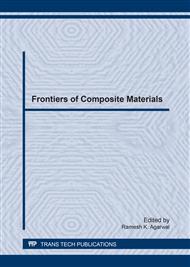p.17
p.21
p.25
p.29
p.34
p.38
p.42
p.46
p.50
Effect of TiB2 Content on Microstructure and Hardness of In Situ TiB2 Reinforced High Zinc Content Al-Zn-Mg-Cu-Zr Composite Materials
Abstract:
TiB2p/Al-10Zn-1.7Mg-1.0Cu-0.12Zr composite was prepared by synthesis of in-situ Al-TiB2 master alloy, high purity aluminum, pure zinc, pure magnesium, Al-50 wt% Cu and Al-4 wt% Zr master alloys. The mass fraction of TiB2 particles was varied from 0% to 9.14%. SEM and TEM were applied to evaluate the microstructure and phase component. HB hardness test were carried out on hardness value of the matrix alloy and the composite. The results showed that TiB2 particles uniformly distributed in the composite and well combined with the matrix alloy. The average grain size of the composites decreased from 110.35μm to 52.07μm when the TiB2 particles is 4.47%, and the grain size changed slightly when TiB2 content increased further. The hardness value of the composites which raised from 189HB to 206HB is superior to that of the matrix alloy. As the content of TiB2 particles increased, HB hardness value also increased.
Info:
Periodical:
Pages:
34-37
Citation:
Online since:
March 2017
Authors:
Keywords:
Price:
Сopyright:
© 2017 Trans Tech Publications Ltd. All Rights Reserved
Share:
Citation:


